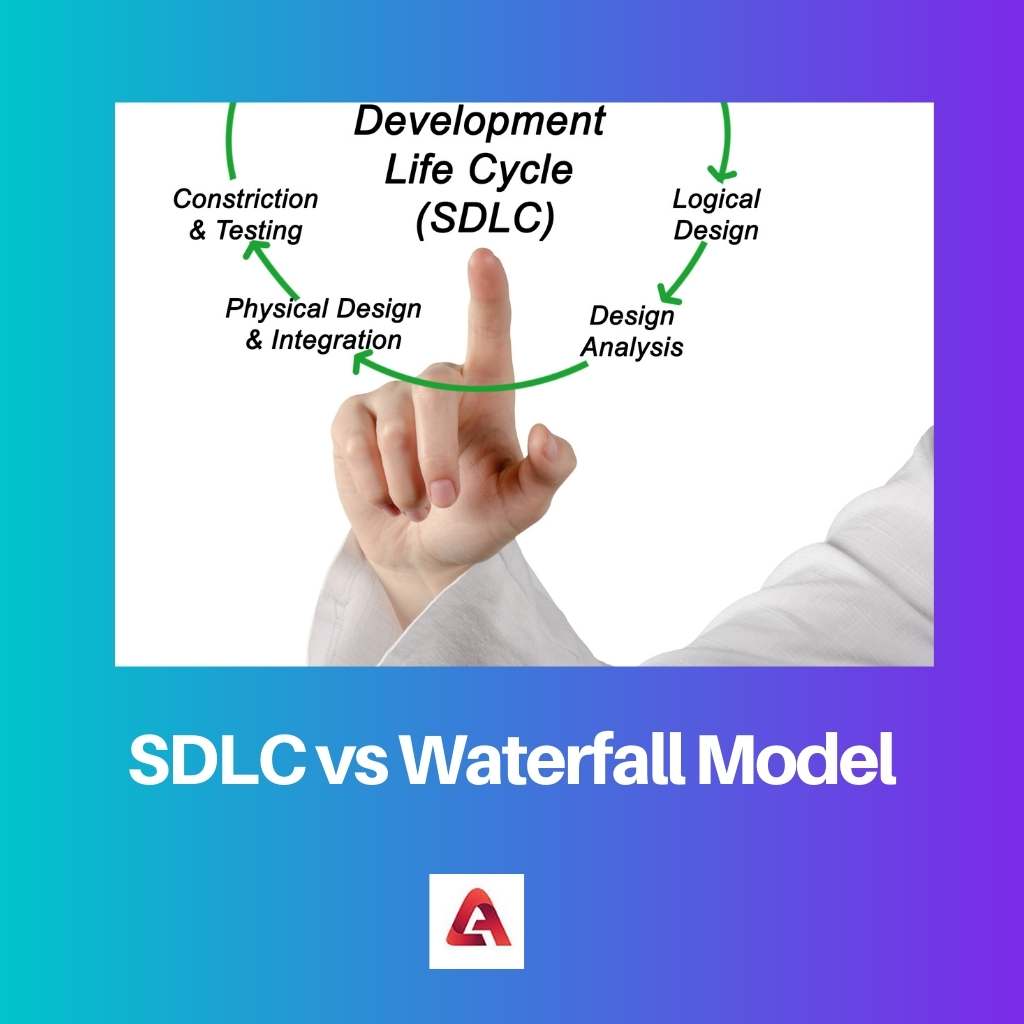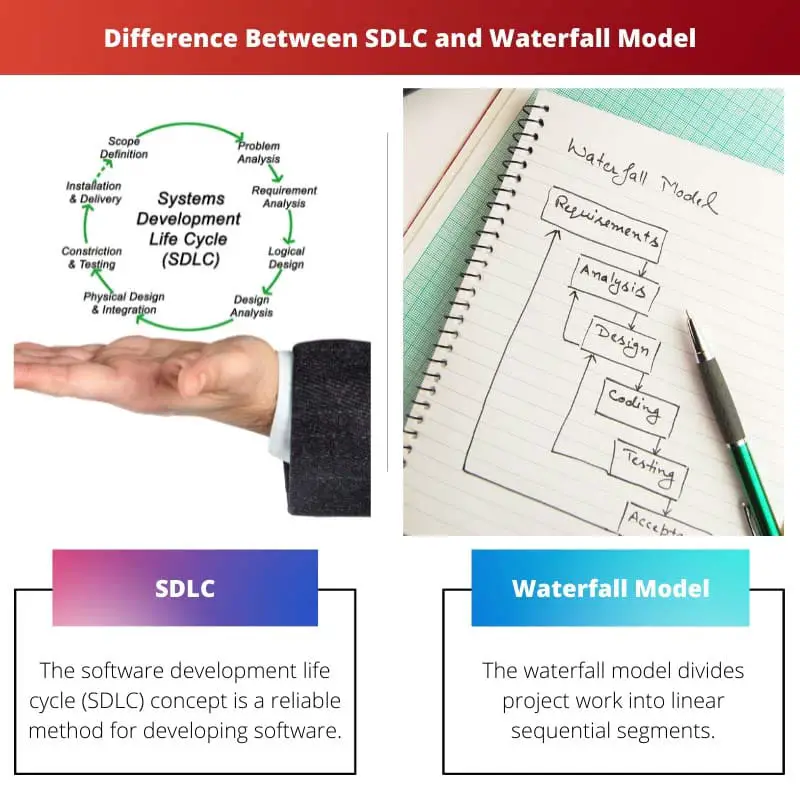A software development life cycle model, or SDLC, is a methodical software development method. To create the final product, a variety of tasks are carried out sequentially.
Each stage is coupled with deliverables that serve as an entry to the following SDLC phase.
Key Takeaways
- SDLC encompasses various methodologies to develop software, including Waterfall, Agile, and Scrum.
- Waterfall Model follows a sequential process with distinct stages, making it less flexible than other SDLC methodologies.
- The Waterfall Model requires the completion of each stage before moving to the next, increasing the risk of project delays.
SDLC vs Waterfall Model
SDLC is a general term that describes the steps of developing software from conception to completion. It includes many stages such as requirements gathering, design, etc. Waterfall model is a software development approach in which each stage of the process is completed before moving on to the next.

The software development life cycle (SDLC) concept is a reliable method for developing software. The result is obtained by combining several tasks that are completed in sequential order.
The many SDLC model stages are listed in the latter. The SDLC paradigm is divided into four phases: requirements, design, implementation, as well as testing.
The waterfall model divides project work into linear sequential segments, each of which is dependent on the outputs of the preceding one and correlates to task specialization. The method is common in certain fields of engineering design.
In most cases, waterfall approaches result in some project timeline that devotes 20–40% of the effort to the very first 2 stages, 30–40% to code, and the remainder to testing and execution.
Comparison Table
| Parameters of Comparison | SDLC | Waterfall Model |
|---|---|---|
| Connotation | SDLC stands for software development life cycle which is a methodology for software development. | The waterfall model divides project work into linear sequential stages, each being dependent on the deliverables of the preceding one and correlates to a task specialism. |
| Interrelation | SDLC designs include the spiral model, the V-shaped model, the incremental life cycle model, and the waterfall model. | The waterfall model is a fashionable software development methodology that employs a sequential as well as linear method of producing software solutions. |
| Clients and Stakeholders | SDLC incorporates feedback from product shareholders and investors since it includes several models. All throughout process, the consumer is kept in the picture as well as his opinion is constantly taken at face value. | Whereas, in case of waterfall model, the required paperwork is completed from the outset. Mostly during the requirement phase is sufficient documentation completed. |
| For Complicated Projects | Since it is a compilation of different software models, SDLC works pretty well for complex projects. | On the other hand, Waterfall Model works better for small projects. |
| Defined of non-defined | SDLC may or may not have defined stages. | Whereas, Waterfall Model has pre decided and defined stages. |
What is SDLC?
The software development life cycle (SDLC) concept is a reliable method for developing software. The result is obtained by combining several tasks that are completed in sequential order. The many SDLC model stages are listed in the latter.
The first is the objectives, which define the program’s users, primary functionalities, and information flows. The second stage is the layout, which creates the detailed aesthetic of the system.
The third stage is deployment, which is the longest phase of the software development life cycle because it applies the designing procedure consisting of code.
The final stage is testing, which involves both systems as well as unit testing. Texting is used to determine whether the code has met the functionality specified in the requirements stage.
SDLC models include the rad model, the V-shaped model, the iterative life cycle model, and the waterfall model.
A waterfall methodology is a fashionable approach to software development that employs a sequential as well as linear method of producing software solutions.

What is Waterfall Model?
The waterfall model divides project work into linear sequential segments, each of which is dependent on the outputs of the preceding one and correlates to task specialization. The method is common in certain fields of engineering design.
Software development is one of the lesser iterative & flexible methodologies because progress is primarily one-way (“downwards” like a waterfall) through the aspects of conceptualization, initiation, assessment, design, building, testing, deployment, as well as maintenance.
The waterfall development paradigm was born in the manufacturing and services industries, where hierarchically structured environmental factors made new designs incredibly expensive much earlier in development.
There have been no acknowledged substitutes for knowledge-based creative output when it was originally embraced for software development.
Herbert D. Benington gave the very first documented presentation detailing the usage of such stages in software engineering on June 29, 1956, somewhere at the Symposium on Advanced Programming Methods for Digital Computers.
This lecture was also on the creation of SAGE software.
Main Differences Between SDLC and Waterfall model
- SDLC stands for software development life cycle, which is a methodology for software development. The waterfall model divides project work into linear sequential stages, each being dependent on the deliverables of the preceding one and correlates to a task specialism.
- SDLC designs include the spiral model, the V-shaped model, the incremental life cycle model, and the waterfall model. The waterfall model is a fashionable software development methodology that employs a sequential as well as linear method of producing software solutions.
- SDLC incorporates feedback from product shareholders and investors since it includes several models. All throughout the process, the consumer is kept in the picture as well as his opinion is constantly taken at face value. Whereas, in the case of the waterfall model, the required paperwork is completed from the outset. Mostly during the requirement phase is, sufficient documentation completed.
- Since it is a compilation of different software models, SDLC works pretty well for complex projects. On the other hand, Waterfall Model works better for small projects.
- SDLC may or may not have defined stages. Whereas, Waterfall Model has pre-decided and defined stages.

- https://www.researchgate.net/profile/Archit-Garg-2/publication/319166101_SDLC_Model_Selection_Tool_and_Risk_Incorporation/links/5b5eb6ff458515c4b2522c80/SDLC-Model-Selection-Tool-and-Risk-Incorporation.pdf
- https://papers.ssrn.com/sol3/papers.cfm?abstract_id=2988291

The given article has provided a thorough explanation of the software development life cycle and the Waterfall Model. The key takeaways and comparisons between SDLC and the Waterfall Model are well-explained. The informative content helps in understanding the methodologies and their differences.
I completely agree with your analysis. The article effectively outlines the stages of SDLC and the Waterfall Model with clarity and detail.
The comparison between SDLC and the Waterfall Model is elucidated with precision in the article. The detailed examination of their differences and applicability is commendable.
I concur with your observation. The historical context provided about the Waterfall Model in the article is indeed intriguing and enhances the understanding of the methodology.
The article effectively explains the varied SDLC models and their significance. It provides a holistic understanding of software development methodologies.
I agree with your perspective. The article’s focus on the history of the Waterfall Model provides an insightful perspective on its origins and relevance in software development.